Intel Core i7 4960X (Ivy Bridge E) Review
by Anand Lal Shimpi on September 3, 2013 4:10 AM EST- Posted in
- CPUs
- Intel
- Ivy Bridge
- Ivy Bridge-E
Video Transcoding
With our lightly threaded tests behind us, it's time to move to more CPU intensive pastures.
We migrated to the latest verison of the x264 HD benchmark which features a much newer version of x264 and a much heavier workload. The focus here is on quality rather than speed, thus the benchmark uses a 2-pass encode and reports the average frame rate in each pass.
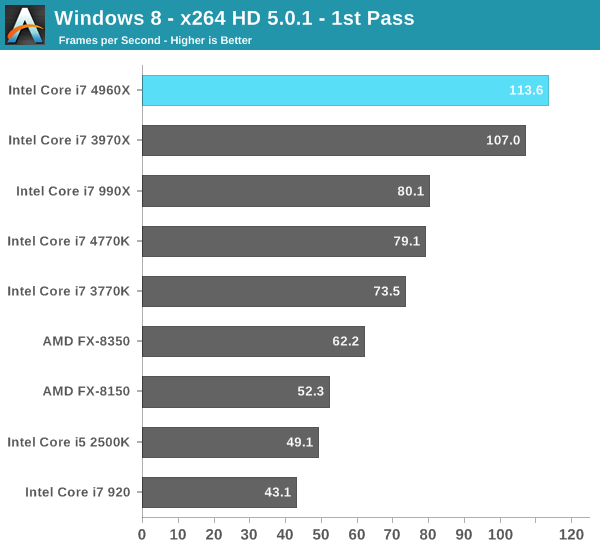

Here we see all of the 6-core parts rise to the top, including Intel's old Gulftown based Core i7-990X. Despite being a few years old at this point, the 990X's 6-core design and relatively high clock speed gives it better performance here than the quad-core Haswell 4770K.
The 4960X manages to be around 30% faster than the old 990X, and is 40% faster than the 4770K. For heavily threaded applications, there's simply no replacement for more cores.
Just like I did earlier, I dusted off one of our really old x264 tests so we'd have comparison data to even older CPUs including the Pentium 4 and Penryn based Extreme Edition parts:
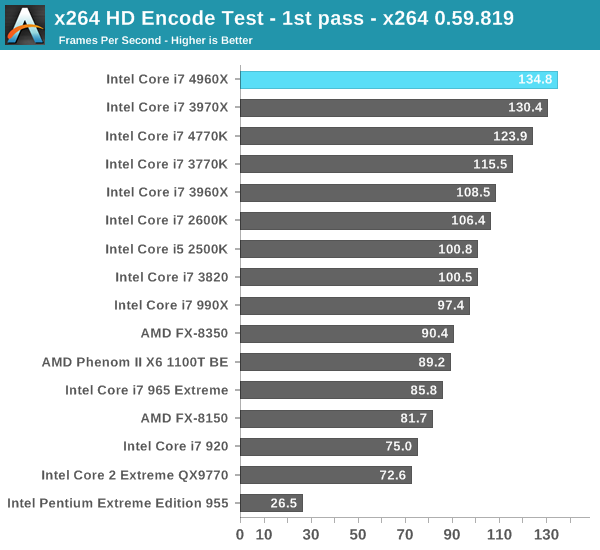
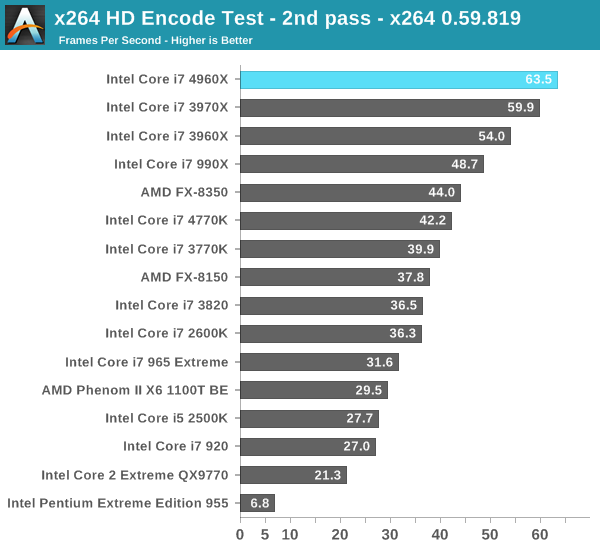
The 4960X manages to deliver nearly 3x the performance of Intel's flagship from 6 years ago. The Pentium EE 955 comparison is even more insane. IVB-E is basically an order of magnitude faster than the last high-end Pentium 4s to come out of Intel back in 2005.
3D Rendering
Our new POV-Ray benchmark uses the latest beta binary (3.7RC6) and runs through both single and multithreaded versions of the popular raytracing benchmark.
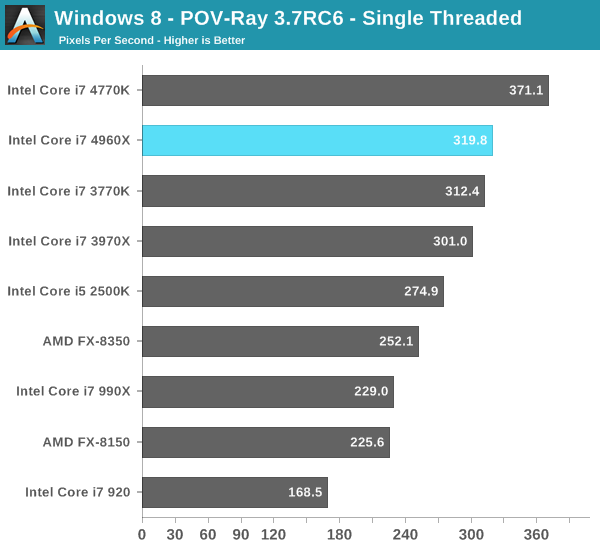
Isolating a single core shows us exactly what we're missing by having Ivy Bridge at the heart of the 4960X instead of Haswell. Here the 4770K manages a 16% performance advantage over the 4960X, which costs 3x as much and draws substantially more power. Looking at AMD's FX-8350 however it's clear why Intel can get away with launching a high-end 6-core chip without its latest cores. Piledriver's single threaded performance falls somewhere between Nehalem and Sandy Bridge, giving Intel room to launch another Ivy Bridge based high-end SKU in 2013 and get away with it.
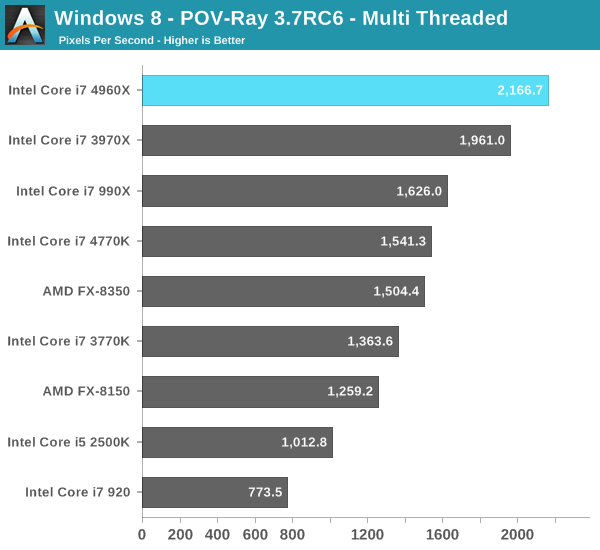
The multithreaded performance story is very different. Here even the Gulftown based 990X is faster than Haswell thanks to its six cores. The 4960X is 40% faster than the Haswell based 4770K. Even AMD's FX-8350 does really well here, basically equalling Haswell's performance.
Created by the Cinema 4D folks we have Cinebench, a popular 3D rendering benchmark that gives us both single and multi-threaded 3D rendering results.
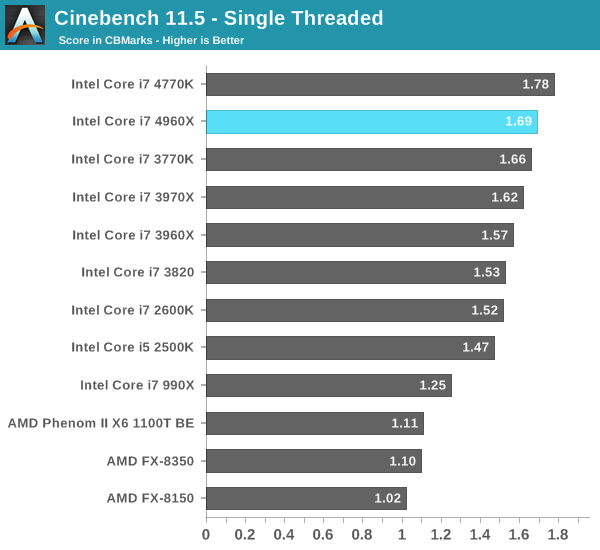
In Cinebench, the single threaded Haswell/IVB-E gap narrows to 5%.
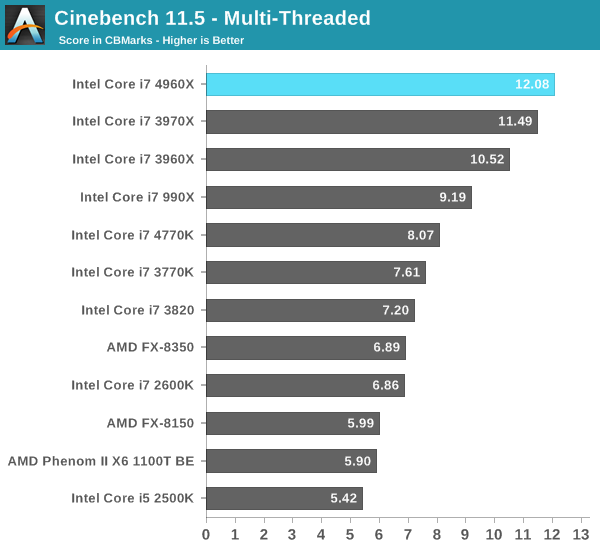
Multithreaded performance continues to be just stellar. Here the 4960X is just under 50% faster than the 4770K. Note the relatively small gap between the 4960X and the SNB-E based 3970X however - the performance gain is only 5%. The bulk of Ivy Bridge's advancements were in GPU performance (not applicable to IVB-E) and power consumption (which we'll get to shortly).
Our final two Cinebench tests use the R10 benchmark to enable a comparison to more/older data points:
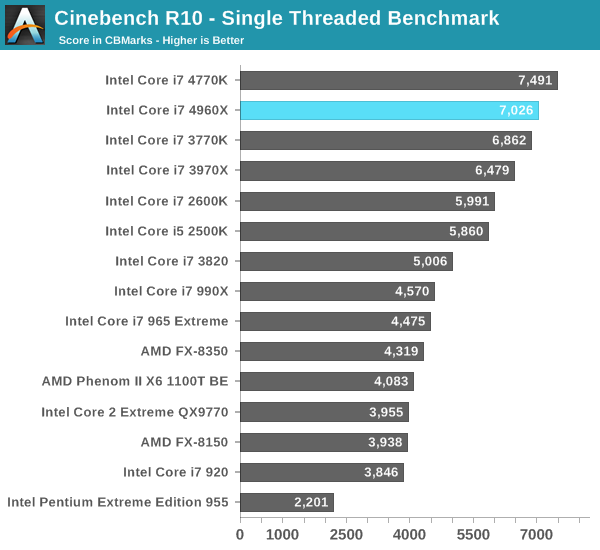
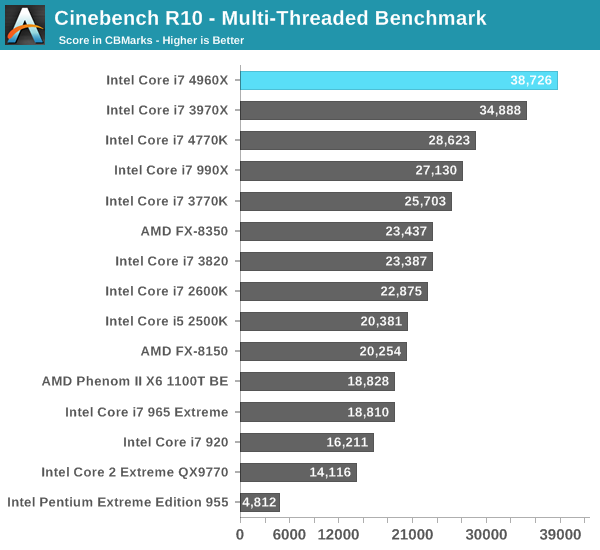










120 Comments
View All Comments
cactusdog - Tuesday, September 3, 2013 - link
IB-E is a massive failure just like SB-E. Thanks Intel for killing the highend for me. Actually, I think this is their plan, to kill the highend. Its ridiculous that this platform is so far behind the mainstream platform. 2x sata 6GB/s ports? No Intel USB 3.0? Worse Single threaded performance than mainstream? Sandy Bridge-e seemed like an unfinished project where many compromises were made and ivy-e looks the same.knweiss - Tuesday, September 3, 2013 - link
Anand, you write that Corsair supplied 4x 8GB DDR3-1866 Vengeance Pro memory for the testbed. However, you also remark "infrequent instability at stock voltages" with 32 GB. Then, in the legend of memory latency chart, you write "Core i7-4960X (DDR3-1600)" .So I wonder which memory configuration was actually used during the benchmarks? Less than 32 GB with DDR3-1866, non-stock voltages, or 32GB DDR3-1600? Wouldn't anything but 4x DDR3-1866 be a little bit unfair because you otherwise don't utilise the full potential of the CPU?
bobbozzo - Tuesday, September 3, 2013 - link
The article says that 1600 is the max memory speed SUPPORTED if you use more than one DIMM per channel.knweiss - Wednesday, September 4, 2013 - link
There are 4 channels.chizow - Tuesday, September 3, 2013 - link
Nice job Anand, your conclusion pretty much nailed it as to why LGA2011 doesn't cut it today and why this release is pretty ho-hum in general. I would've liked to have seen some 4820K results in there to better illustrate the difference between 4770K Haswell and SB-E, but I suppose that is limited by what review samples you received.But yeah, unless you need the 2 extra cores or need double DIMM capacity, there's not much reason to go LGA2011/IVB-E over Haswell at this point. Even the PCIe lane benefit is hit or miss for Nvidia users, as PCIe 3.0 is not officially supported for Nvidia cards and their reg hack is hit or miss on some boards still.
The downsides of LGA2011 vs LGA1150 are much greater, imo, as you lose 4 extra SATA3(6G) ports and native USB 3.0 as you covered, along with much lower overall platform power consumption. The SATA3 situation is probably the worst though, as 2 isn't really enough to do much, but 6 opens up the possibility of an SSD boot drive along with a few really fast SATA3 RAID0 arrays.
TEAMSWITCHER - Tuesday, September 3, 2013 - link
I'm really disappointed by these numbers. As a software developer, the FireFox compile benchmark best indicates the benefit I would get from upgrading to this CPU. And, it looks like the 4770K would be about the same difference - except far less expensive. I really don't think I need anything more than 16GB for RAM, and one high-end graphics card is enough to drive my single WQHD (2560x1440) display. Do bragging rights count? No...I mean really?madmilk - Tuesday, September 3, 2013 - link
Time to consider Xeons...MrBungle123 - Tuesday, September 3, 2013 - link
What's a Xeon going to do? Be slower than the 4960X? You lose clock speed by going with huge core counts and that translates to even more losses in single threaded performance. There comes a point where there are diminishing returns on adding more cores... (see AMD)MrSpadge - Tuesday, September 3, 2013 - link
Time to save yourself some money with a 4770 - not the worst news.Kevin G - Wednesday, September 4, 2013 - link
Your best bet would be to hope for desktop CrystalWell part. That extra cache should do wonders for compile times even if you'd lose a bit of clock speed. However, Intel is intentionally holding back the best socket 1150 parts they could offer as the benefits of Crystalwell + TSX optimized software would put performance into large core count Xeon territory in some cases.